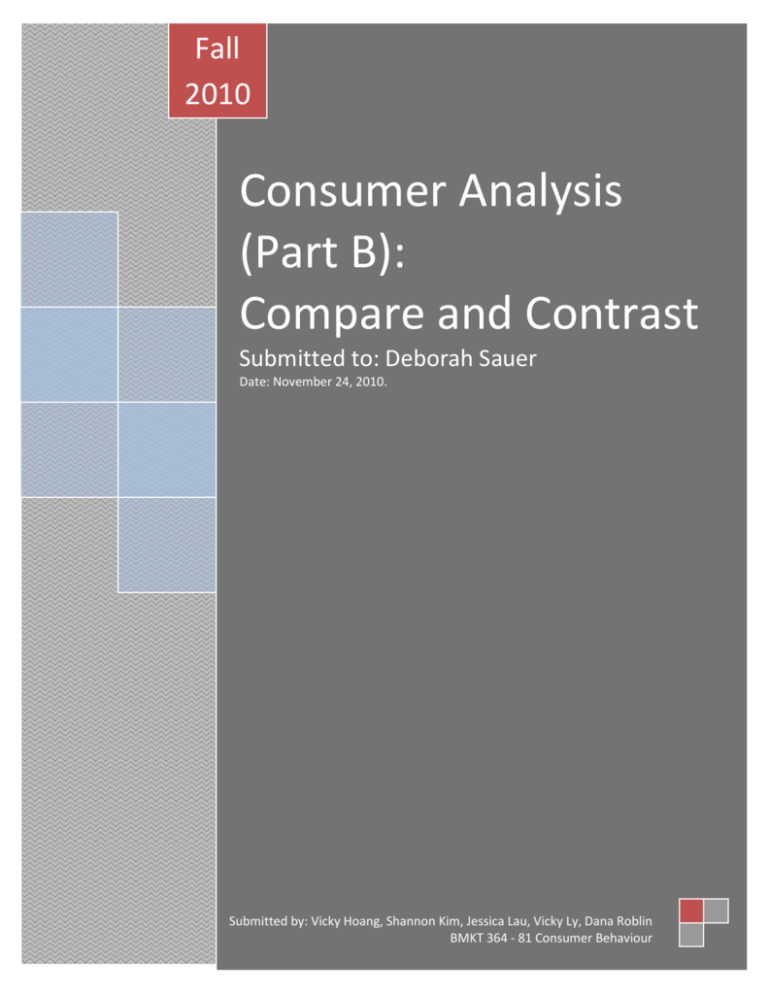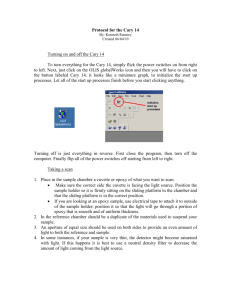CB – Customer purchases comparison
advertisement

Fall 2010 Consumer Analysis (Part B): Compare and Contrast Submitted to: Deborah Sauer Date: November 24, 2010. Submitted by: Vicky Hoang, Shannon Kim, Jessica Lau, Vicky Ly, Dana Roblin BMKT 364 - 81 Consumer Behaviour Table of Contents REPORT INTRODUCTION.............................................................................................................................................3 DEMOGRAPHIC CONSUMER PROFILES.......................................................................................................................3 DESCRIPTION OF THE PRODUCT PURCHASED ............................................................................................................4 Chapter 9: Decision Making Process Change to black ...............................................................................................4 Step 1: Problem Recognition ..............................................................................................................................4 Step 2: Information Search .................................................................................................................................5 Step 3: Evaluation of alternatives.......................................................................................................................7 Step 4: Product Choice .......................................................................................................................................7 Step 5: Consumption and learning .....................................................................................................................9 Chapter 10: Buying and Disposing ..............................................................................................................................9 Antecedent States ..............................................................................................................................................9 Purchase Environment .................................................................................................................................... 11 Post Purchase Processes ................................................................................................................................. 12 Summary and Conclusion ................................................................................................................................ 13 Appendix A..............................................................................................................................................................14 2|Page REPORT INTRODUCTION Consumer behaviour is the study of the processes involved when individuals or groups select, purchase, use, or dispose of products, services, ideas or experiences to satisfy needs and desires. In this specific research analysis project, our group has chosen two particularly distinctive consumers with different demographic backgrounds to execute an in-depth study of purchasing behaviour, with relevance to the consumer behaviour concepts learned in class. To illustrate these concepts, our two interviewees, Cary Lau and Anna Huynh, have been asked a series of questions in relation to a recent vehicle purchase they made from the initial problem recognition stage through to the post-purchase processes. The purchase decision making process comprises of five steps that a consumer experiences, usually with products that involves more time and effort. These five steps include the problem recognition, information search, evaluation of alternatives, product choice, and the outcome. In addition, this report will discuss the individual’s choices that can be influenced by several factors such as his/her mood, the perceived risks involved, the urgency and reason for the purchase, to name a few. DEMOGRAPHIC CONSUMER PROFILES Name: Cary Lau Name: Anna Huynh Age: 45 years old Age: 22 years old Residency: Richmond, BC Residency: Burnaby, BC Occupation: BMW Gold Sales Master Occupation: Shaw Communications Representative and student Contact Number: 604.222.7788 Contact Number: 604.561.0515 Marital Status: Married Marital Status: Single Dependents: None Dependents: None 3|Page DESCRIPTION OF THE PRODUCT PURCHASED Purchased 6 months ago, Cash Deal Purchased November 9th 2010 Pre-owned 2009 Porsche 9/11 New 2011 Kia Sorrento, SUV Carerra White in color White in color $100,000 CAD $40,000 CAD Automatic Porsche PDK transmission Automatic transmission Added aftermarket upgrades through Fully-loaded package: leather seats, another dealership Purchased from dealership in the moon roof, GPS system United States (Bellevue, WA) Purchased from Kia Vancouver dealership Chapter 9: Decision Making Process Step 1: Problem Recognition Both consumers recognized their problem as an opportunity to purchase a new vehicle. Cary’s lease on his previous sports car had expired, therefore triggered the desire to purchase another vehicle, this time a more exotic sports car. On the other hand, Anna’s initial response to purchase a new vehicle arose when her current vehicle was having mechanical problems. She was also frequently exposed to nicer vehicles on a regular basis which triggered her ideal state; to own a properly functioning, new and attractive car. Both consumers had suggested that as time passed, their needs and tastes had evolved; therefore their current vehicle model was no longer desirable in the purchasing decision of a new car. Both primary and secondary demand is not relevant in either of the two cases. Cary and Anna both have been driving for a number of years and have previously owned a vehicle. In terms of being persuaded to use a specific brand, Anna was focusing on the monetary value in various vehicles meanwhile Cary was looking for a visually attractive sports car which depicted his brand choice. 4|Page Step 2: Information Search Both consumers recognized that their purchase decision would consist of weighing the pros and cons of each alternative, since the purchase is not an impulse buy and encompasses higher risk and consumer involvement. However the degree in searching for information varied amongst the two consumers since Cary had a significant advantage over Anna in terms of internal search of prior knowledge and experience. Cary had formerly owned cars similar to his ideal vehicle; an exotic sports car. He is also currently employed at a car dealership as one of the top salesperson and consequently has gained first-hand knowledge about essential functions of similar vehicles. On the contrary, Anna is a younger consumer, attending University while working part-time at Shaw Communications Inc. Her prior experience and knowledge about cars is from her previous ownership of her Pontiac; however, the brand is no longer operating and therefore comparing brands with her existing knowledge was difficult. Given Cary’s existing product knowledge of vehicles, his information search was more focused and time efficient as he knew where to look and what particular information to look for. He used the internet as a primary search engine to find relevant information on websites such as BMW, Mercedes, Lexus, and Porsche. He looked at the features, availability, colors, and options and compared these factors amongst these different brands. In addition, Cary also consulted his wife and friends who also owns a similar model of the vehicle he was considering. In order for Anna to make a rational purchase decision, she had to conduct an extensive information search since she had limited product knowledge. Although Anna had an idea of the brand of vehicle she wanted, she did not have enough information in her memory to evaluate the alternatives effectively; therefore, she complemented her existing knowledge with external search including friends, family, dealers, consumer reports, and online sources. Both consumers experienced directed and incidental learning but the degree varied in proportion to the differences between the two consumers in terms of experience, product knowledge, and daily exposure to vehicles. It follows that the two consumers engaged in pre-purchase search and ongoing search differently due to their unique backgrounds and history. In Cary’s case, his prepurchase search was very limited because he had specific brands already in mind that would fit his needs for an exotic sports car. Meanwhile, Anna began her pre-purchase search for specific information on different types of vehicles that she would take into account for her purchase decision. Cary performed more ongoing search than Anna since he was heavily involved in the 5|Page Porsche brand and his intentions were to build a bank of information for future use, especially when it came to modifying and altering his car. Anna’s search for a new vehicle can be described as variety seeking since she previously owned a van and as her needs changed; she felt that an SUV would be more suitable. However Cary had previously owned several sports cars and in his purchase decision, he continued to remain loyal to the product category. Biases in the consumers’ purchase decisions that may have occurred include, mental accounting and sunk-cost fallacy. Fortunately for these two consumers, the biases were not present. Neither consumers’ frame of problem affected their purchase nor did they consider sinking more money into their previous vehicle to try to avoid a sunk cost. The perceived risks varied between the two consumers when purchasing a new vehicle due to their diverse lifestyles and characteristics. Anna was more vulnerable to the monetary risk especially when she felt guilty after her purchase of spending a large sum of money; however, Cary earns a substantially higher income, hence, the dollar value of the vehicle was a diminutive risk to him. The functionality of the vehicle also exposed a risk to both consumers because Anna is a very practical consumer and Cary demanded four specific functions in his purchased vehicle: Sports Chrono package, PDK Porsche Transmission, Bluetooth and USB accessibility. Similarly, the consumers mutually agreed on the fact that there was a social risk involved in the purchase of a new vehicle because Anna and Cary considered not only how they would personally feel with their product choice as it reflects who they actually are or ideally want to be, but also how their friends and family would react to their choice. Psychological factors were also considered as a risk in both cases but Cary’s situation had a higher risk since he had a reputation and expectations to meet of being a higher income earner and working in a prestige dealership. In addition, Anna also considered her purchase of a vehicle to be a psychological risk and social risk, in terms of how her friends would respond and either approve or disapprove of her choice of vehicle. Finally, Anna did not perceive any physical risk when making her purchase decision because she understood that all vehicles were similar in safety and therefore it was not a factor in her information search. Conversely, Cary recognized that purchasing a fast sports car could be dangerous to the safety of the passengers, as well as those in his surroundings such as pedestrians, cyclists, and other motor vehicles on the road. However Cary did not put great emphasis on this type of risk in his purchase decision. 6|Page Step 3: Evaluation of alternatives Since both of our consumers went through an extended problem solving process, they managed to evaluate several brands of vehicles. Both consumers endured difficult trade-offs; although habitual decision making did not occur as they both considered several brands. Each consumer’s evoked set presents differences with one similarity, BMW. Anna’s evoked set included all SUV’s while Cary’s included all luxury cars. To recall, Anna’s evoked set included Ford Edge, Acura MDX and Kia Sorrento from her retrieval set and Honda CRV, and BMW X3 from her environment. In contrast, Cary’s evoked set comprised of both his retrieval set and those prominent in the environment which happened to be all the same and included Porsche, Lexus, Mercedes and BMW Not sure what type of Lexus and Porsche. Anna had heard of Hummer but because of the price range and other factors, it never made it past her inert set; Cary included Ferrari and Lamborghini in his inert set. Ironically, Anna’s final choice of vehicle was part of Cary’s inept set, including Honda, Acura and Toyota. Toyota was also included in Anna’s inept set of vehicles she avidly avoided, in addition to Mercedes, Honda, and American cars. Both consumers evaluated their alternative brands in terms of what they already knew about their previous vehicle. Because they both were considering different brands than their previous vehicle, they relied on their current knowledge to help them gather new information relevant to the brands they were considering. Categorization is a critical factor of how a vehicle is evaluated. For a specific brand of vehicle to stimulate information processing, it should either be strongly associated with what is referred to as “calling the shots” or “the unusual.” In Cary’s case, he identified Porsche as one of the exemplar brands, more specifically the one that calls the shots and for that reason he referred to it when he evaluated his other alternatives. Anna’s exemplar brands fell under more of the unusual brands category, specifically the budget brands that included Kia and Ford. When vehicles fail to fall into any specific category, they can often confuse consumers when attempting to locate that vehicle. Fortunately this did not occur for our consumers. Step 4: Product Choice After thorough evaluation of the consumers’ alternatives, they were finally ready to make a decision on their vehicle choice. Both of our consumers relied on three decision rules to decide on their purchase. These included prior experience of vehicle, present information, and beliefs about 7|Page the different brands. Cary and Anna both took into consideration their old vehicles and this determined their requirements for their current vehicle purchase. They both also held beliefs about certain brands due to advertising; however, their final decision weighed on more criteria content. Anna relied on information from a variety of sources while Cary relied more on information from his wife and current needs. Anna’s evaluative criteria consisted of, the number of seats, the physical appeal, the gas per mileage, the price/financing, and the user friendliness of the vehicle. Her determinant attributes are rated and shown in Appendix A. These factors were critical in Anna’s purchase of a Kia over her other alternatives. Similarly, Cary also included price in his evaluative criteria, in addition to the availability, functionality, accessibility of obtaining vehicle, customization and warranty. His determinant criteria are also displayed and rated in Appendix A. Neuromarketing did not occur in either situation for our consumers as no brain scanning took place nor were the consumers’ reactions measured. Although both of our consumer’s went through extensive decision making processes, they also held certain heuristics that could have helped speed up the process. Both consumers shared a similar rule of thumb in that the more expensive the vehicle, the better quality, durability, and value-added services to the car, although in this specific case, Anna did not follow her heuristic in the purchase process. Another rule of thumb that Cary abides by but Anna doesn’t, is that one should always test drive a vehicle before purchasing it. Unlike a purchase of a pair of sneakers, cars neither are refundable, exchangeable nor credited back to your account. In the case of our consumers, Zipf’s Law does not apply as they did not prefer or choose the number one brand according to them. In Cary’s situation, some might think that Porsche is in fact the number one brand but he believes it to be Lamborghini or Ferrari. Anna’s concern was more on fulfilling her needs, as oppose to purchasing the number one vehicle brand. Inertia did not occur in either case as the purchase was not out of habit. POP displays, price reductions or brand out of stock would not have impacted our consumer’s purchase. Contrary to inertia, Anna mentioned that she would have purchased a Pontiac again had they remained in business. She still holds a positive attitude towards Pontiac based on the brand loyalty she developed over her past purchases. Evidently through his previous purchases, Cary was not committed to a particular brand therefore had no brand loyalty. Due to the complexity of the purchases, both of our consumers considered many vehicle attributes by using a compensatory decision rule. This rule is 8|Page usually used in high-involvement situations such as our consumers’ vehicle purchases and includes evaluating the pros and cons of each alternative. Although both of the consumers would have liked to have everything on their wish list, they were willing to compromise and allow certain attributes to compensate for poorer ones. Step 5: Consumption and learning Cary and Anna both have expressed positive reviews on their product choice and experience as of date. The two consumers indicated that their new vehicles have not only met their initial requirements, but even surpassed their expectations. Cary’s purchase of a $100,000 Porsche was an expensive decision that had a relatively high risk, yet he did not experience any cognitive dissonance due in part to the dealership’s follow-up emails and appreciation letters. Anna also received satisfaction follow-up emails and phone calls which reassured her product choice. Both consumers received approval from their family and friends, adding to the contentment of each purchase. Chapter 10: Buying and Disposing Antecedent States When comparing both consumers, it is evident that Anna and Cary had a different perception and feeling about time pressure and constraint, which affected their purchasing process. Anna’s specific purpose for the purchase of the SUV was to replace her old and run-down Pontiac van, as oppose to Cary’s reason due to his lease expiry of his previous car, created time pressure and restrictions. Furthermore, Anna suffered from time poverty as she visited the dealership close to closing time, whereas Cary visited during the afternoon hours, giving him adequate amount of time to explore his options. Cary took a lot of time finalizing and deciding on his purchase when he was at the dealership and spent little time researching before going to the dealership. While in Anna’s case, when she was at the dealership, her decision was more rushed, but her research process had been more thoroughly thought out, thus signalling the different beliefs of “time is money” for our two consumers in the situation. This difference may be a combination of many factors but it is something contrasting in this particular stage of the purchasing situation and worth noting. 9|Page Anna’s usage context and purchase criterion was family oriented and solely based on her family’s change in needs for a vehicle, while Cary’s purchase was more leisurely geared. The process of having to purchase the KIA Sorrento made Anna consider the role that she plays in her family as the eldest sibling, having to take charge of the purchasing decision and helping to pay for the vehicle. Alternatively, for Cary, his usage context was to satisfy the need of a vehicle and fulfill the want of being socially accepted. Cary had initially mentioned that the main reason triggering him to get the Porsche was because he had seen an acquaintance on the road driving one, which increased his want for a luxurious vehicle. Moreover, being one of the top salesperson in a prestige dealership gave puts the expectation for him to have a luxurious vehicle. Another major contributing factor as to why Cary opted for a sportier vehicle rather than the family-oriented SUV is because he is married without children, allowing him to enjoy the luxury lifestyle mentality of doing whatever he wants, whenever he wants. The comparison of both consumers’ mood evidently shows they were filled with excitement throughout the purchase process at the dealerships; however, Anna was more eager and anxious during the process due to the time she has exhausted on the process, whereas Cary was feeling ecstatic and relaxed. All of the moods experienced by both consumers were caused by their psychological perceptions, physical and social surrounding In regards to the physical surrounding, both consumers mentioned the appearance of the showroom gave them a great impression and affected their perception and purchase process. With Anna, the open layout, excellent presentation of cars, cleanliness and the smell of new car gave her a feel of trustworthiness and comfort. Whereas with Cary, the brightly lit, spacious, contemporary, professional physical surrounding filled with the smell of new cars and mellow background music gave him a feeling of relaxation and welcoming. In terms of the social surrounding, both consumers experienced a surrounding where the showroom weren’t overly crowded and filled with customers. They felt that it gave them a relaxed feeling and allowed them to shop comfortably without pressure to make a rushed decision. Take out spaces in between paragraphs or else change chapter 9 to make it consistent Both dealerships were filled with friendly salespeople, who played an important role in the consumers’ purchases. Although Anna’s salesperson was relatively new and was not as knowledgeable with the products, his friendliness and attentiveness was sufficient enough to be substituted for the exchange of value of excellent customer service, which ultimately influences 10 | P a g e the purchasing decision. Cary’s exchange of value for the luxurious purchase was due to a combination of both the salesperson possessing extensive product knowledge, as well as patience and helpfulness. Anna was more influenced than Cary in the comparison of the two consumers’ temporal factors. Since Anna had conducted extensive research about her purchase she felt that as time for her purchase drew closer, she was becoming more anxious to make her purchase. In contrast, Cary’s background in the automotive industry made his researching process rather short and simple; his anxiety lied in his purchase of the new car rather than the process itself. Spacing between paragraphs Anna’s shopping orientation can be described as an apathetic and economic consumer where she doesn’t normally enjoy shopping and is a more rational, goal-oriented shopper; dissimilarly, Cary is classified more as a recreational shopper. One of the main reasons we characterized Anna as an economic consumer was due to the fact that she predicted her vehicle would last her for the duration of four years. This amount of time is considered to be a long-term commitment and therefore she believes she should get the most value for her purchase. Cary enjoys taking his time when shopping as he views shopping as leisure, social and fun activity for himself. Similar to Anna, Cary also expects that his car purchase will expire in the next four years, but because of his higher level of disposable income and his shopping orientation, he is accepting the fact that his vehicle might require maintenance within the duration time, or replacement of a new car if needed. Purchase Environment Both consumers did not make their vehicle purchase online because they both believed the importance of test-driving a vehicle before you purchase it. Anna and Cary both recognized that the purchase is a permanent item. And both consumers mentioned that due to the limited or nonrefundable, exchange or credit policy of a vehicle, it is important to make sure the vehicle is what you expect. With this common belief, both consumers did not utilize E-Commerce for their vehicle purchase. Although both consumers referred to E-commerce in the research process in comparing different specifications, features, colors, and options, they did not utilize it for the actual purchase of product. 11 | P a g e Both consumers’ vehicle purchases were planned purchases, however, they differ greatly in the time they took in deciding on their purchases. Anna planned her purchase for about 8 months before making a decision versus Cary, who planned for about one month before making a decision. When comparing both consumers, Anna was pushed to make a purchasing decision due to the dealership’s offer of a point of purchase stimuli of the additional keyless entry device. Cary, on the other hand, was not affected by any point of purchase stimuli. Post Purchase Processes In consideration to post-purchase satisfaction, Anna was very satisfied with her dealership; she appreciated how the dealership has gone out of their way by contacting her and ensuring that the purchase of her SUV was moving along smoothly. However, Anna also experienced dissatisfaction in her post-purchase because of a miscommunication about a promotion that had initially sparked our consumer’s interest in the dealership. Cary, however, did not experience any dissatisfaction in his purchase process. Cary’s post-purchase satisfaction was accomplished as his expectations for his overall experience and physical content of the car was met. Similar to Anna’s situation, his post-purchase anxiety was greatly reduced by the salesperson as they sent him congratulatory letters and appreciation emails concerning the satisfaction of his vehicle; these small but effective methods of communications creates brand loyalty and reassurance for customers such as Cary and Anna. While Cary’s post-purchase satisfaction was met because his expectations for his overall experience and physical content of the car. This sentence doesn’t make sense Also, Cary’s postpurchase anxiety was reduced by the salesperson at the dealership because they had sent him congratulatory letters and appreciation e-mails regarding the purchase of his vehicle, these methods of communication helped Cary feel reassured about his purchase. In Anna’s situation, her Pontiac had been a write-off, while in Cary’s situation his vehicle went back to a dealership to be sold or leased to another individual. Since Anna’s purchase of her KIA Sorrento was made to fulfill the need of an old vehicle that was in need of replacement because of the condition it was in, her and her family decided that they would trade in the vehicle when they purchased their KIA, so they received a monetary reduction in the purchase of their KIA by disposing their Pontiac at the KIA dealership. While Cary’s previous car was assigned to him through a lease, and his need arose when his lease was coming to an end. Therefore, Cary 12 | P a g e disposed of his vehicle by returning it to the original dealership where he had initially received his leased vehicle. Summary and Conclusion Throughout this research analysis, we compared and contrasted the steps that our two consumers took when purchasing a high-involvement product, SUV and sports car. Our Consumers recognized their problem as an opportunity and subsequently went through a series of steps in the decision-making process. They participated in an extensive information search to determine their best alternatives and identified those alternatives based on their evoked set. Next, they decided on their vehicle choice by evaluating their alternatives from criteria they individually developed. Anna’s ultimate chose was the KIA Sorrento, because its pro’s outweighed its con’s. Cary’s final decision was the Porsche as it covered most of his criteria. Both consumers were satisfied with the outcome of their purchase decision. We then took a look at buying and disposal factors, including antecedent state and situational factors like the time of the day the purchase occurred and how these factors affected how our consumers felt. Another aspect discussed was the importance/irrelevance of e- commerce, as our consumers are from different generations. Anna is considered a new infoshopper because she turned to the internet for information first, whereas Cary is not a new infoshopper as he relied more on friends and hands-on experience. They both agreed though that purchasing a vehicle over the internet was not an option due to the high-involvement. Another factor addressed was the purchase environment and how the ambiance and the retail location presentation had an impact on the ultimate purchase, and how Anna is an economical consumer while Cary has more disposable income to spend on a vehicle. Finally, we mentioned our consumers’ post-purchase process and how they were both pleased to hear from the dealership a few days after their purchases to ensure everything was okay. To conclude, after our thorough analysis of our consumers and their purchases of a Kia and Porsche, we were able to effectively compare and contrast concepts from Consumer Behaviour to a purchasing decision with a high-involvement product. Through this assignment, we were given the opportunity to explore the similarities and differences that two consumers can have when participating in the decision making process. 13 | P a g e APPENDIX A Car BMW Mercedes Lexus Price 3 1 2 Availability 1 1 3 Accessibility of 2 1 3 Functionality 3 1 1 Physical 3 1 2 Brand reputation 1 1 3 brands Cary’s Determinant attributes obtaining purchased vehicle appearance 1 = yes, 2 = sort of, 3 = no 14 | P a g e Car BMW- KIA- MDX Sorrento Edge Gas mileage 3 1 2 7-seat 1 1 3 User friendly 2 1 3 Price 3 1 1 Interior/ exterior 3 1 2 V6 ( strong 1 3 brands FORD- Anna’s Determinant attributes 1 engine) 1 = yes, 2 = sort of, 3 = no 15 | P a g e






